
Venice is a city in northeastern Italy and the capital of the Veneto region. It is built on a group of 118 small islands that are separated by expanses of open water and by canals; portions of the city are linked by over 400 bridges. The islands are in the shallow Venetian Lagoon, an enclosed bay lying between the mouths of the Po and the Piave rivers. In 2020, around 258,685 people resided in greater Venice or the Comune di Venezia, of whom around 51,000 live in the historical island city of Venice and the rest on the mainland (terraferma). Together with the cities of Padua and Treviso, Venice is included in the Padua-Treviso-Venice Metropolitan Area (PATREVE), which is considered a statistical metropolitan area, with a total population of 2.6 million.
Alvise Cadamosto or Alvise da Ca' da Mosto was a Venetian explorer and slave trader, who was hired by the Portuguese prince Henry the Navigator and undertook two known journeys to West Africa in 1455 and 1456, accompanied by the Genoese captain Antoniotto Usodimare. Cadamosto and his companions are credited with the discovery of the Cape Verde Islands and the points along the Guinea coast, from the Gambia River to the Geba River, the greatest leap in the Henrican discoveries since 1446. Cadamosto's accounts of his journeys, including his detailed observations of West African societies, have proven invaluable to historians.

Antonio Pigafetta was a Venetian scholar and explorer. He joined the expedition to the Spice Islands led by explorer Ferdinand Magellan under the flag of the emperor Charles V and after Magellan's death in the Philippine Islands, the subsequent voyage around the world. During the expedition, he served as Magellan's assistant and kept an accurate journal, which later assisted him in translating the Cebuano language. It is the first recorded document concerning the language.
Francesco da Mosto is an Italian architect, author, historian, film maker and television presenter. He presented the three BBC 2 series Francesco's Venice (2004) and Francesco's Italy: Top to Toe (2006) where he explored the country in an Alfa Romeo Spider and Francesco's Mediterranean Voyage which sees him sailing aboard the Camper and Nicholsons ketch Black Swan from his home city, Venice, to Istanbul, visiting places including Split, Mostar and Dubrovnik. He presented the two part BBC 2 series: Shakespeare in Italy, (2012).
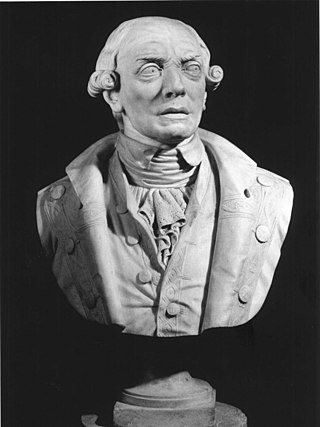
Angelo Emo was a Venetian noble, administrator, and admiral. He is notable for his reforms of the Venetian navy and his naval campaigns, being regarded as the last great admiral of the Venetian Republic.
Francesco's Italy: Top to Toe is a four-part BBC television series hosted by Francesco da Mosto and originally shown on BBC Two from 11 June to 2 July 2006. In the series, da Mosto drives his Alfa Romeo Spider the length of Italy, from North to South, exploring the architecture and traditions in different regions.
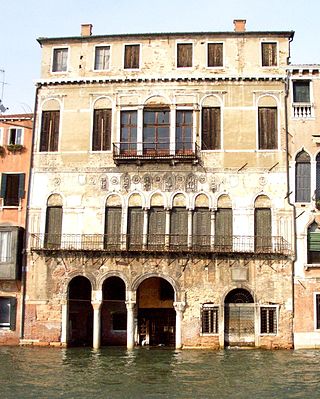
The Ca' da Mosto is a 13th-century, Venetian-Byzantine style palace, the oldest on the Grand Canal, located between the Rio dei Santi Apostoli and the Palazzo Bollani Erizzo, in the sestiere of Cannaregio in Venice, Italy. Today, it is home to the Venice Venice Hotel.
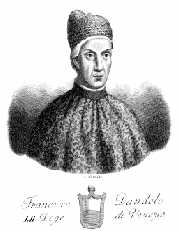
Francesco Dandolo was the 52nd Doge of Venice. He ruled from 1329 to 1339. During his reign Venice began its policy of extending its territory on the Italian mainland.

The Domini di Terraferma was the hinterland territories of the Republic of Venice beyond the Adriatic coast in Northeast Italy. They were one of the three subdivisions of the Republic's possessions, the other two being the original Dogado (Duchy) and the Stato da Màr.
Francesco's Venice is a four-part BBC television documentary series hosted by Francesco da Mosto and first broadcast on BBC2 in 2004. The series follows da Mosto as he explores the history of Venice, beginning with its creation in the 5th century and concluding in the modern era. Each episode focuses upon a certain area of Venetian history, interlaced with various anecdotes from da Mosto's own experiences and family history. A book of the same name was published to accompany the series in 2004.
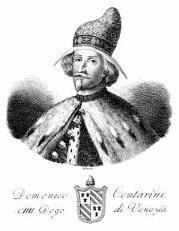
Domenico II Contarini was the 104th Doge of Venice, reigning from his election on October 16, 1659 until his death.

The office of Procurator of Saint Mark was one of the few lifetime appointments in the government of the Venetian Republic and was considered second only to that of the doge in prestige. It was routinely occupied by nobles belonging to the most influential families and typically represented the climax of a distinguished political career, although it was often an intermediate position prior to election as doge.

The Senate, formally the Consiglio dei Pregadi or Rogati, was the main deliberative and legislative body of the Republic of Venice.
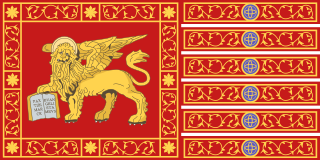
The Ionian Islands were an overseas possession of the Republic of Venice from the mid-14th century until the late 18th century. The conquest of the islands took place gradually. The first to be acquired was Cythera and the neighboring islet of Anticythera, indirectly in 1238 and directly after 1363. In 1386, Corfu voluntarily became part of Venice's colonies. A century later, Venice captured Zante in 1485, Cephalonia in 1500 and Ithaca in 1503. The conquest was completed in 1718 with the capture of Lefkada. Each of the islands remained part of the Venetian Stato da Màr until Napoleon Bonaparte dissolved the Republic of Venice in 1797, annexing Corfu. The Ionian Islands are situated in the Ionian Sea, off the west coast of Greece. Cythera, the southernmost, is just off the southern tip of the Peloponnese and Corfu, the northernmost, is located at the entrance of the Adriatic Sea. In modern Greek, the period of Venetian rule over Greek territory is known as Venetokratia or Enetokratia and literally means "rule of the Venetians". It is believed that the Venetian period on the Ionian Islands was agreeable, especially compared with the coinciding Tourkokratia — Turkish rule over the remainder of present-day Greece.

The island of Cyprus was an overseas possession of the Republic of Venice from 1489, when the independent Kingdom of Cyprus ended, until 1571, when the island was conquered by the Ottoman Empire.
The Bailo of Corfu was the leader of the Venetian delegation to the island of Corfu who oversaw the affairs of the island while under Venetian rule and protected the commercial and military interests of the Republic of Venice. The first mention of a bailo in Corfu is in 1386 and is found in a Greek chronicle. The bailo of Corfu is also mentioned in a document by historian Marco Guazzo from 1544.

The Venetian navy was the navy of the Venetian Republic which played an important role in the history of the republic and the Mediterranean world. It was the premier navy in the Mediterranean Sea for many centuries between the medieval and early modern periods, providing Venice with control and influence over trade and politics far in excess of the republic's size and population. It was one of the first navies to mount gunpowder weapons aboard ships, and through an organised system of naval dockyards, armouries and chandlers was able to continually keep ships at sea and rapidly replace losses. The Venetian Arsenal was one of the greatest concentrations of industrial capacity prior to the Industrial Revolution and responsible for the bulk of the republic's naval power.
Gregory Dowling is an author, translator, literary critic and Professor of Anglo-American Literature at the Università Ca’ Foscari in Venice.

The Provveditore Generale da Mar was the most senior peacetime office in the Venetian navy and in charge of governing the Venetian overseas empire.
The Savi[i] agli Ordini or Savi ai Ordini were senior magistrates of the Republic of Venice, charged with supervision of maritime matters, including commerce, the Venetian navy and the Republic's oversees colonies.




































